
Every sales leader has faced it, the moment when the business shifts and the team must adapt fast. A new ICP. A price increase. A product launch. A move upmarket.
We plan, enable, and train. But readiness isn’t about preparation; it’s about capacity. The real question isn’t “Did we train the team?” It’s “Can the system hold the change?”
That’s the essence of sales readiness for change: the ability to stay confident, clear, and connected when everything shifts.
Sales readiness for change is the ongoing capability of a sales team to adapt confidently to new conditions, pricing, ICP, product, or process shifts, without losing momentum. It’s built through three core levers: confidence, trust, and reflection, reinforced through rhythm and leadership modeling.
Every market shift tests more than your sales process, it tests your adaptability. According to McKinsey & Company, 70% of sales transformations fail not because of bad strategy, but because teams aren’t psychologically ready to change how they sell.
Readiness determines how quickly a sales org moves from understanding a change to executing it. The most successful teams we see aren’t the ones with the best playbooks; they’re the ones who can absorb disruption without losing rhythm.
Unreadiness looks like confusion, fatigue, and resistance masked as “busy.” When readiness is missing, leaders see:
The cost isn’t just lost revenue, it’s lost energy. Unreadiness drains the team’s capacity to believe in change, and belief is what drives performance.
Readiness is the inner stability that allows a team to hold external change. It’s less about perfect training decks and more about the psychology that keeps teams learning, not locking up. Three inner capacities define sustainable readiness:
1. Confidence - Permission to Experiment
Change blossoms in environments where people feel safe enough to try new things. Confidence grows when reps see small wins and leaders normalize iteration. Pressure kills creativity; confidence revives it. When a pricing update launches, readiness isn’t knowing the script, it’s believing “I can handle the objection.”
2. Trust - Alignment that Scales
Trust transforms directives into dialogue. Teams that trust leadership adopt faster because they believe the change is built with them, not to them. Research has show that high-trust teams are 2.6x faster adopting new strategies.
3. Reflection - Rhythm that Sustains
Speed is valuable; reflection makes it sustainable. Teams that pause weekly to ask, “What did we learn that will help next week?” recover faster from setbacks and avoid fatigue. Reflection turns motion into progress.
Traditional enablement focuses on skills and process. Sustainable readiness focuses on the system those skills live in.
1. Emotional Readiness: Can the team hold pressure without fracturing? Teams that regulate energy outperform by 20% in quota attainment.
2. Relational Readiness: Deals move at the speed of internal trust. When relational health is high, feedback flows, alignment tightens, and cross-functional friction drops.
3. Cultural Readiness: Does everyone share a clear story about why you sell? Cultures that connect daily actions to purpose renew faster after setbacks. When all three align, readiness becomes the bridge between potential and performance.
Change readiness isn’t built in workshops, it’s sustained through rhythm. Here are practices sales leaders can implement immediately:
1. Reflection Rituals: Start team meetings with one grounding question: “What pattern did we notice this week that will help us next week?” It builds learning velocity faster than any dashboard review.
2. Feedback Loops: Make feedback bidirectional, from leaders and reps. Psychological safety compounds when every voice matters.
3. Regenerative Pacing: Build recovery into your workflow. After major pushes (launches, events, quarter closes), schedule deliberate pauses. Performance thrives in systems that know how to breathe.
4. Shared Language of Change: Introduce words like “readiness,” “rhythm,” and “renewal” into team vocabulary. Language shapes culture; culture shapes behavior.

1. What is sales readiness for change?
It’s the ongoing ability of a sales team to adapt to shifts, product, pricing, process, while maintaining confidence, trust, and focus.
2. How is readiness different from enablement?
Enablement trains for skills; readiness builds the conditions where those skills stick.
3. How can leaders measure readiness?
Use trust and reflection surveys, energy pulse checks, and adoption velocity after change events.
4. How long does readiness take to build?
With consistent rhythm and reflection, measurable improvement happens within 60–90 days.
5. What’s the biggest barrier to readiness?
Rushing, teams under constant urgency can’t build the reflection needed to adapt.
Your high-performing sales team starts here.